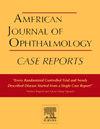Comparative evaluation of anterior lens capsule electron microscopic pathology in a case undergoing simultaneous bilateral cataract surgery: A study of CAPSULaser and continuous curvilinear capsulorhexis
Q3 Medicine
引用次数: 0
Abstract
Purpose
To identify ultrastructural changes, such as thermal effects and lens cortex penetration, to assess the potential benefits of CAPSULaser for future use in patients with complex cataract conditions.
Observation
Histological examination of the CAPSULaser-treated tissue revealed sections of the anterior capsule, cuboidal epithelial cells, and lens cortex collagen fibers. The edges of the tissue were slightly bent toward the anterior side, displaying a thermal effect measuring 62.12 μm in width. The tissue strip showed irregular thickness, with a maximum lens cortex collagen fiber thickness of 237.1 μm. Under TEM, the capsular margins appeared fragmented, exhibiting bulbous edges and a bubbly appearance. In the cauterized areas, electron-dense materials obscured and distorted the attached epithelial cells and lens fibers, in contrast to the preserved central region. Conversely, light microscopy of the CCC specimen showed sharp, well-demarcated edges tapering from anterior to posterior, and it was thinner than the CAPSULaser specimen. Notably, the CCC specimen lacked lens cortex collagen fibers, consisting solely of the anterior capsule and cuboidal epithelial cells. Ultrastructurally, the CCC specimen's edges appeared angulated and well-dermacated.
Conclusion and importance
Our study indicates that the cauterized edges of the CAPSULaser specimen tend to fold toward the anterior side, emphasizing the role of collagen phase changes in enhancing tissue elasticity. This study reported both histopathological and TEM findings, particularly for CAPSULaser, offering valuable insights into the microscopic changes in the anterior capsule when comparing CCC and CAPSULaser.
同时行双侧白内障手术1例前晶状体囊电镜病理的比较评价:囊状激光和连续曲线撕囊术的研究
目的通过观察晶体的超微结构变化,如热效应和晶状体皮层穿透,评估未来应用于复杂白内障患者的潜在益处。组织学检查显示前囊、立方上皮细胞和晶状体皮层胶原纤维切片。组织边缘向前方轻微弯曲,显示宽度为62.12 μm的热效应。组织条厚度不规则,晶状体皮层胶原纤维最大厚度为237.1 μm。透射电镜下,被囊边缘呈碎片状,呈球根状边缘和泡状外观。在烧灼区,电子致密物质掩盖和扭曲了附着的上皮细胞和晶状体纤维,与保留的中央区域相反。相反,光镜下的CCC标本显示出从前到后逐渐变细的尖锐、界限清晰的边缘,并且比荚膜标本更薄。值得注意的是,CCC标本缺乏晶状体皮层胶原纤维,仅由前囊和立方上皮细胞组成。在超微结构上,CCC标本的边缘呈角状,剥皮良好。结论和重要性:我们的研究表明,被烧灼的囊膜标本的边缘倾向于向前方折叠,强调胶原相变化在增强组织弹性中的作用。本研究报告了组织病理学和透射电镜的发现,特别是对capsule的发现,在比较CCC和capsule时,为前囊的微观变化提供了有价值的见解。
本文章由计算机程序翻译,如有差异,请以英文原文为准。
求助全文
约1分钟内获得全文
求助全文
来源期刊

American Journal of Ophthalmology Case Reports
Medicine-Ophthalmology
CiteScore
2.40
自引率
0.00%
发文量
513
审稿时长
16 weeks
期刊介绍:
The American Journal of Ophthalmology Case Reports is a peer-reviewed, scientific publication that welcomes the submission of original, previously unpublished case report manuscripts directed to ophthalmologists and visual science specialists. The cases shall be challenging and stimulating but shall also be presented in an educational format to engage the readers as if they are working alongside with the caring clinician scientists to manage the patients. Submissions shall be clear, concise, and well-documented reports. Brief reports and case series submissions on specific themes are also very welcome.
 求助内容:
求助内容: 应助结果提醒方式:
应助结果提醒方式:


